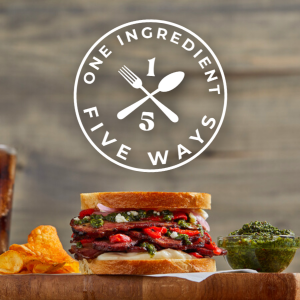Plant-Based vs. Plant-Forward
What’s the difference?
“Plant-Based”: Consisting or made entirely of plants, or mainly of plants. This focuses on the use of fruits, vegetables, legumes, whole grains, nuts and seeds. Attention to these types of foods has increased the popularity of vegetarian and vegan diets. ( Cambridge English Dictionary)
“Plant-Forward”: A term coined by the culinary community to describe in a more detailed way the promotion of vegetables and alternative proteins without completely striking out meat. It is also a more relatable term that includes the larger, general population. (Produce Business)
Whether we call it “plant-based” or “plant-forward” may not really matter. These two phrases can be used interchangeably. They both have the same goal: getting more produce on the plate.
How to Position Plant-Forward
1. Conscious Mind & Body
Everyone seems to be seeking functionality in food these days and it just so happens that all plants are packed with various vitamins, minerals and compounds that have some sort of functional benefit. The Plant-Forward and Functional Food trends fall as one when considering Mind & Body. We are seeing consumers gravitate towards well-rounded well-being; not only wanting a healthy body but for mental and emotional health as well.
Operators can capitalize on these trends by
- Listing all benefits of the ingredients and their preparation
- Focusing on the holistic factors of the dishes
- Creating new functional food combinations and naming them as such
- Ex: Brain Power Bowl
2. Global Experimentation
Gen Z and Millennial consumers are diverse demographics influencing the introduction of more ethnic food options. As demand for ethnic fare grows, curiosity follows. Mainstream ethnic flavors from Europe and East Asia will no longer suffice; cuisines from the Middle East, Eastern Europe, and Southeast Asia show greater opportunity. (2018 Technomic, Ethnic Food & Beverage Consumer Trend Report)
The search for ethnic will no longer be introduced in a very generalized manner. Consumers want to know the region these foods originate from and what makes them authentic.
As new culinary regions are being introduced, familiar regions, like Mexico, Asia, and the U.S., are being broken down into regional cuisine and reintroduced. A deeper dive into these familiar regions will bring a new appeal to flavors and ingredients with which consumers are already familiar.
Operators can offer a dish with a type of sauce that is new to their customer base and
- Call out regions from which the flavors originate
- Dig deep and name the product after the region that inspired the application
3. Convenience
In the last 2 years, the demand for grab-and-go food options has increased resulting in more convenient food options for consumers. A second wave has turned these on-the-go meals into something more elevated as competition grows and more to-go options are being introduced. All the flavor and ingredient trends that are currently expected at Full-Service Restaurants are now being applied to all handheld food items (e.g. tacos, sandwiches, or sliders).
Brands are taking convenience to a new level by making day-to-day processes and tasks thoughtless and bringing foods to where the consumers are. There is now simplicity in all aspects of life. It goes past the traditional sense of the word that typically meant “quick and easy” and has transformed into a demand for “don’t make me think” or “give me exactly what I need.” (Winsight Grocery Business)
Operators can take advantage of this trend by
- Offering plant-forward in handheld and convenient options
- Creating items for all day parts
- Having one dish with a choice of protein source – it’s all about having options


